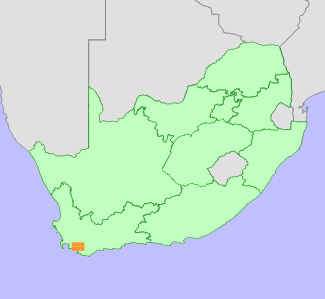|
Scientific Name | Paranomus bolusii (Gand.) Levyns |
Higher Classification | Dicotyledons |
Family | PROTEACEAE |
Synonyms | Nivenia crithmifolia R.Br., not Paranomus crithmifolius Salisb. ex Knight |
Common Names | Overberg Sceptre (e) |
National Status |
Status and Criteria | Near Threatened B1ab(iii)+2ab(iii) |
Assessment Date | 2020/05/12 |
Assessor(s) | A.G. Rebelo, H. Mtshali & L. von Staden |
Justification | Paranomus bolusii is a range-restricted species with an extent of occurrence (EOO) of 1303 km², and an area of occupancy (AOO) of 404 km². It is however locally abundant, and still persists at between 13 and 16 locations. A continuing decline is inferred from increasing competition from alien invasive plants, and therefore this species nearly meets the criteria thresholds for Vulnerable under criterion B. |
Distribution |
Endemism | South African endemic |
Provincial distribution | Western Cape |
Range | This species is endemic to the Western Cape, South Africa, where it occurs from the Groenland to Kleinrivier Mountains. |
Habitat and Ecology |
Major system | Terrestrial |
Major habitats | South Sonderend Sandstone Fynbos, Overberg Sandstone Fynbos, Kogelberg Sandstone Fynbos, Greyton Shale Fynbos, Elgin Shale Fynbos, Elim Ferricrete Fynbos, Western Coastal Shale Band Vegetation |
Description | It grow in sandstone fynbos and on shale bands, at 20-840 m. Mature individuals are killed by fires, and only seeds survive. Seeds are released after ripening, and dispersed by ants to their underground nests, where they are protected from predation and fire. It is pollinated by insects. |
Threats |
| This species' preferred habitat is ideally suited for agriculture, particularly fruit orchards, and outside protected areas, there is ongoing habitat loss to agricultural expansion in the lowland areas, with 3% habitat loss recorded between 1990 and 2014. Paranomus bolusii has also lost habitat to gravel mining.
Alien invasive plants, particularly escaped Pinus, Acacia and Eucalyptus species continue to spread and increase in Groenlandberg, Caledon Swartberg as well as parts of the Kleinrivier Mountains. If these are not controlled, they are likely to increase rapidly over the next 15-20 years to such densities that this species is likely to be outcompeted. |
Population |
Paranomus bolusii extends over a 47 km-long range, many of its lowland subpopulations on silcretes and shales have been decimated. However, it is still extremely abundant at higher altitudes, primarily on sandstone. Over 100 subpopulations are known, and only 14 of these are small and isolated. The population continues to decline due to habitat loss and degradation.
|
Population trend | Decreasing |
Conservation |
| It is present at Groenlandberg, Houwhoek, and Caledon Nature Reserves, and Witdraai Private Nature Reserve. |
Assessment History |
Taxon assessed |
Status and Criteria |
Citation/Red List version | | Paranomus bolusii (Gand.) Levyns | VU A2c | Raimondo et al. (2009) | |
Bibliography |
Goldblatt, P. and Manning, J.C. 2000. Cape Plants: A conspectus of the Cape Flora of South Africa. Strelitzia 9. National Botanical Institute, Cape Town.
Manning, J.C. and Goldblatt, P. 2012. Plants of the Greater Cape Floristic Region 1: The Core Cape Flora. Strelitzia 29. South African National Biodiversity Institute, Pretoria.
Raimondo, D., von Staden, L., Foden, W., Victor, J.E., Helme, N.A., Turner, R.C., Kamundi, D.A. and Manyama, P.A. 2009. Red List of South African Plants. Strelitzia 25. South African National Biodiversity Institute, Pretoria.
Rebelo, T. 2001. Sasol Proteas: A field guide to the proteas of southern Africa. (2nd ed.). Fernwood Press, Vlaeberg, Cape Town.
|
Citation |
| Rebelo, A.G., Mtshali, H. & von Staden, L. 2020. Paranomus bolusii (Gand.) Levyns. National Assessment: Red List of South African Plants version 2024.1. Accessed on 2025/12/23 |
 Comment on this assessment
Comment on this assessment

